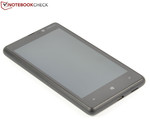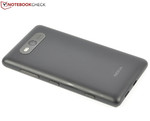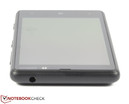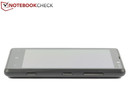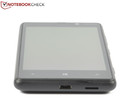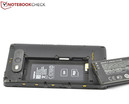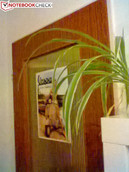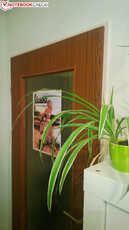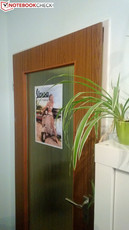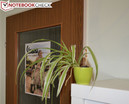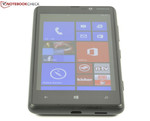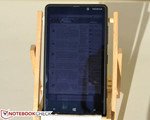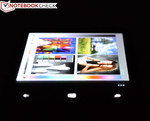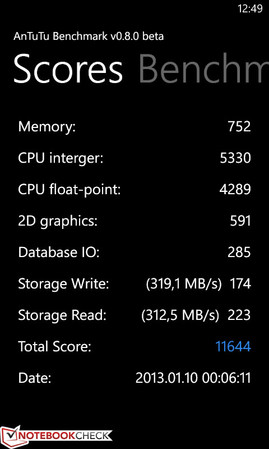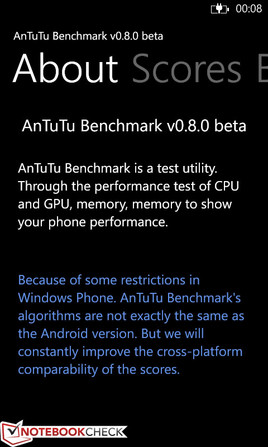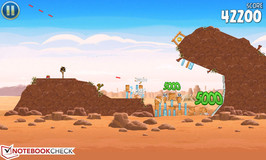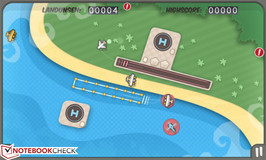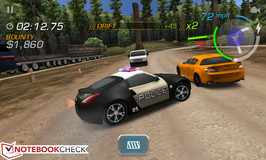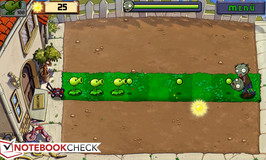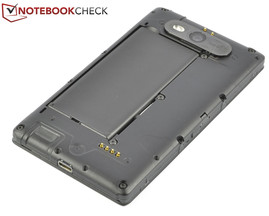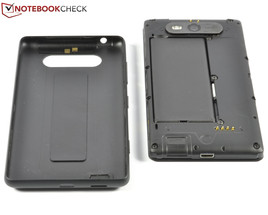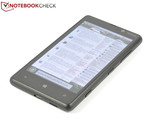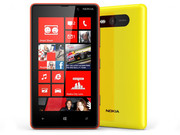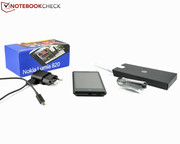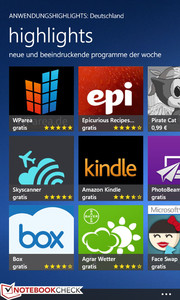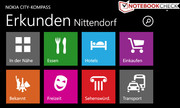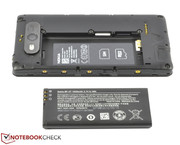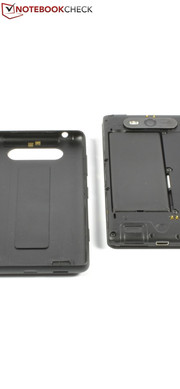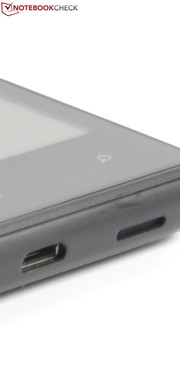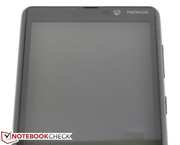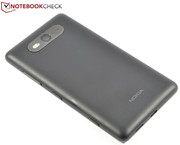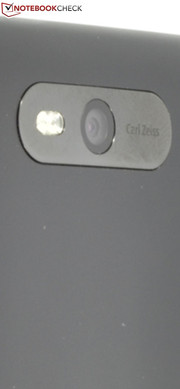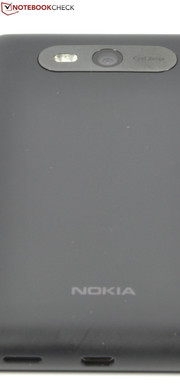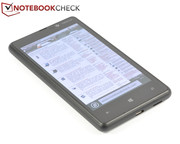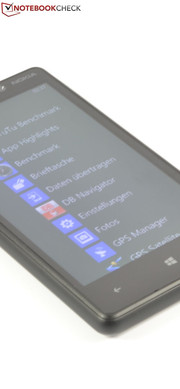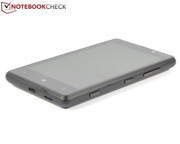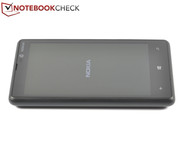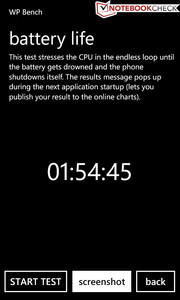Review Nokia Lumia 820 Smartphone
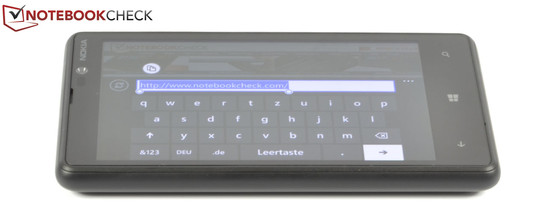
For the original German review, see here.
Nokia's influence as a market leader in the mobile sector has ebbed over time. One reason for this was the belated break with its outdated Symbian operating system for an alternative. Now Microsoft relies on a select group of manufacturers for launching Windows Phone 8, to whom Nokia belongs alongside Samsung and HTC. Unlike the competition, Nokia focuses solely on Microsoft's newest operating system and thus wants to regain its former superiority.
Nokia places the Windows Phone 7.5 based Lumia 800 successor between its premium model Lumia 920 and the entry-level Lumia 620 device. Thus, the midrange Lumia 820 smartphone has to compete against HTC's 8X. To achieve this, Nokia packs a few features into the Lumia 820, which the Lumia 920 already presented. For example, the primary camera from Carl Zeiss though only with a 5 megapixel resolution alongside a dual LED flash, a few proprietary apps, a PETA band LTE module and a high-def 4.3-inch AMOLED screen featuring 217 ppi. Also, 8 GB of flash memory is available, which can be expanded up to 64 GB via a micro SD card. Nokia currently charges 499 Euros (~$667, RRP) for this bundle. Is it justified? To find out, we sent Nokia's Lumia 820 through our exhaustive test course.
Case
A stylish basic could also be a fitting name for our test device. The non-slip, matte-black coated rear shell is made of rigid polycarbonate and can be swapped with white, blue, red, yellow, purple and gray covers. In contrast to the Lumia 920's unibody design, the Lumia 820's chassis is divided. The exchangeable 1650 mAh battery can be accessed when the lightly rounded rear cover is removed. The slots for a micro SIM and micro SD card are beneath that. The casing's shape is nice to hold and reminds us of HTC's Mango-based Titan (Windows Phone 7.5) which featured the same build but in an aluminum chassis. The Lumia 820 makes a very stable impression despite the prevalent plastic.
The casing can only be warped marginally even when high force is applied. The device is comfortable to hold, which is due to its pleasant feel with the rounded forms as well as the high weight of just below 160 grams. The dimensions of 123.8 x 68.5 mm (w x d) and a height of 9.9 mm do not look fragile but a screen size of 4.3-inches has to be accommodated. HTC's 8X looks much less bulky and although it features almost the same size (132.4 x 66.2 x 10.2 mm), it weighs 30 grams less - not to mention the much slimmer and smaller iPhone 5. These massive differences suggest a backlog in development compared with experienced manufacturers. However, it could also be an attempt to stick out from the competition.
Connectivity
Nokia's Lumia 820 is only available in one flash memory version. However, unlike the Lumia 920 premium model, the 8 GB flash memory in our test device can be expanded up to 64 GB via micro SD cards. The potential buyer should order one right away because only around 5 GB of the 8 GB is really useable. Microsoft additionally offers 7 GB of online storage in the cloud via SkyDrive.
As to interfaces, Nokia also follows the minimalistic standard of the genre. The 3.5 mm jack on the casing's upper edge allows connecting the included in-ear headset and enhances the sound via the Dolby headphone. Data sharing is possible via the micro USB port on the smartphone's lower edge. The Lumia 820 is also charged over this port. Nokia optionally offers a replacement cover that enables wireless charging.
Software
Microsoft's Windows Phone 8 operating system powers the Lumia 820, which we previously examined in the review of HTC's 8X. The user interface is the same on every device and the smartphone manufacturer cannot modify it. The animated tile surface might be a matter of taste, but we find it very appealing. Its use is intuitive and clearly arranged. The only option for the manufacturer to individualize the software is to install self-developed apps.
The Lumia 820 comes with the usual bloatware (e.g. sports app, news app, hotel search app, etc.), but fortunately they do not get out of hand. Of course Nokia did not miss the opportunity of installing many proprietary apps. Among others, we find Nokia Drive Beta+ free navigation app (the corresponding maps come from Navteq) and Nokia Maps. With exception of Google Maps, similar apps from iOS or Android are usually very expensive. Comprehensive support software dubbed Nokia Care is also installed. All proved to be very well-developed apps that worked reliably in the practical tests.
Communication & GPS
As to the communication options, the test device is in no way inferior to the Lumia 920. The fast 802.11 a/b/g/n Wi-Fi standard is also implemented in the Lumia 820, which enables transmissions in both the 2.4 and 5 GHz frequency range. The connection worked very reliably even with a few rooms between the device and the router. GSM, including support for the four main frequencies (850, 900, 1800 and 1900 MHz), Edge, HSPA+ (UMTS / 3G) and PETA band LTE. Unlike the iPhone 5, Nokia's Lumia 820 does not only support Long Term Evaluation (LTE) via certain providers (like the German Telecom), but all 4G frequencies available in some countries (such as Germany). The SIM card slot underneath the battery accepts micro SIM cards. A compulsory Bluetooth module is also installed, though in the somewhat outdated 3.0 +EDR version. Besides that, Nokia installs an NFC chip (Near Field Communication) in the Lumia 820, which is not yet widely distributed in some countries. The Lumia 820 communicates with position satellites via A-GPS and Glonass. The test device exhibited a stable connection quality, which was very good outdoors and barely deteriorates indoors, just like the Lumia 920. Its accuracy is also high.
Telephony
The telephone tile is at the home screen's top left in the Windows Phone 8 default settings. Like all tiles, its size can be modified or it can be deleted when preferred. An alphabetically ordered app list, which also includes the telephone app, appears when wiping to the left. The handling is intuitive and the functions are available to the same extent as known from other operating systems. In addition to the number pad, the user can also access personal contacts, a search field or the mailbox here. Convenient: numbers displayed in an email or browser window can be directly called without having to awkwardly copy and paste them in the telephone app.
Cameras & Multimedia
Nokia installs an 8 megapixel, or 3264x2448 pixel primary camera alongside a dual LED flash in the Lumia 820. The Lumia 820 also features autofocus. It can conveniently be accessed over the dedicated camera button on the casing's right and features two very palpable pressure points. The camera is triggered when it is kept pressed in standby. A short tap is enough when it is on. Nokia uses a Tessar objective from the renowned brand Carl Zeiss as the lens. The fixed aperture value is f2.2 at a focal length of 26 mm. A x4 zoom slightly enlarges distant objects but also increases the image noise. This also occurs when the minimum focal range of 10 cm to the object is undercut. Videos can be recorded in Full HD (1080p) at 30 frames per second and are good in sufficient brightness. The flash can be added here when necessary. The diverse settings have been completely adopted from the Lumia 920 premium model. Regrettably, a menu point for directly selecting the image quality has also been omitted. Nevertheless, options like ISO and exposure values or picture mode are appealing. The camera takes good pictures in an appealing quality providing that the ambient light is sufficient. Depending on the setting, the LED flash is automatically enabled and reduces the image noise. According to Nokia, the LED illuminates objects up to a distance of 3 meters, which we could almost confirm in our tests. Nevertheless, it does not completely prevent image noise. Pictures drift into a distinct warm hue with slightly distorted colors in artificial light.
The front-facing camera has noticeably been slimmed down in comparison with the Lumia 920. It merely features a low VGA resolution of 0.3 megapixels, which is simply no longer up-to-date. The picture quality in the test was below average. Focused pictures were not possible even after several attempts and the image noise is disproportionately visible. The front-facing camera is at most suitable for the occasional video chat in good light.
Accessories
The customer gets the usual accessories for Nokia's Lumia 820 at a current street price of 400 Euros (~$535). Besides the smartphone and the 1650 mAh battery, there is a user's manual, USB cable with the corresponding charger and an in-ear stereo headset alongside three alternative ear plugs in the colorful box. Other accessories are recommended on Nokia's product page. For example, rear shells in diverse colors and some that enable wireless charging, as well as the corresponding charging cradle. The Lumia 820 even works with the charging pillow from the beanbag chair manufacturer Fatboy. Nokia has also entered into a prestigious collaboration with the well-known accessories manufacturer Monster and offers a Bluetooth headset matching to the smartphone.
Warranty
Opposing the trend, Nokia includes a 24 month warranty on the Lumia 820. The battery and accessories are covered for 12 months. Strangely, the charger is excluded and is only protected for 6 months.
Input Devices & Controls
Inputting text via a virtual QWERTY keyboard needs a bit of practice because of the cramped key field. But with experience, it is a piece of cake. The slightly wider keys in landscape mode enhance the positive impression even more. Regrettably, Nokia does not completely use the available room and the key layout remains unaltered. We adversely noticed that approximately two-thirds of the available room is taken up from the on-screen keyboard in landscape mode so that the displayed screen is very small. The address bar is positioned directly above the keyboard when using Internet Explorer and facilitates one-handed use. The automatic screen rotation when turning the smartphone is implemented quickly. Using the touchscreen is overall smooth and precise; fingers glide with agreeable ease over the glass surface.
The Lumia 820's screen dubbed "ClearBlack AMOLED" by Nokia features a 15:9 aspect ratio at a screen diagonal of 4.3-inches (10.9 cm) and has a resolution of 480x800 pixels. Nokia builds in a contrast-enhancing polarization filter and an ambient light sensor that automatically adjusts the brightness when enabled. The casing does not stick out on the screen's edges and leaves the screen's glass unprotected. The pixel density of 217 ppi was subjectively compelling in the test. However, contenders like HTC's Windows Phone 8X or Nokia's Lumia 920 easily surpass this rate with 342 ppi and 332 ppi respectively. Even Apple's iPhone 5 or Google's Nexus 4 clearly outperform the test device with 326 and 320 ppi.
The screen only places itself in the lower midfield with an average brightness of 297 cd/m² and a maximum of 318 cd/m². The device is superior to the maximum 283 cd/m² of Google's Nexus 4 and slightly ahead of the 293.8 cd/m² of HTC's Windows Phone 8X. The upper brightness top rank is still reserved by Apple's iPhone 5 with 486.8 cd/m². Even Nokia's Lumia 920 scores a much higher 321.9 cd/m². Regardless of that, Nokia's Lumia 820 supplies the same, very good brightness distribution of 89%, like the Lumia 920.
| |||||||||||||||||||||||||
Brightness Distribution: 89 %
Center on Battery: 288 cd/m²
Contrast: 28800:1 (Black: 0.01 cd/m²)
The theoretical black value of 0.01 cd/m² and a calculated contrast of 28800:1 for construction-related reasons is first rate. The OLED technology completely turns off pixels that are to remain black, which results in a very dark black. We notice a very focused picture, crisp and bright colors as well as a breathtaking contrast subjectively. A higher brightness would have enhanced this impression even more. Overall, a very good presentation from the Lumia 820.
Theoretically, Nokia should be able to perfectly cope with outdoor use in view of a maximum brightness of 318 cd/m². However, the brightness could have been a bit higher considering the very reflective glass surface and thus ensure perfect legibility even in direct sunlight. Otherwise, the displayed content remained easily readable even outdoors.
Owing to the 4.3-inch screen's AMOLED technology, the viewing angles remain stable from every position. Restrictions are only experienced in unfavorable light. Otherwise, color distortions or brightness losses do not occur even at extreme angles, as can be seen on our screenshot of a slanted view. However, the picture is a bit overexposed and is not really faithful. The viewing angle category does not give reason for complaint seen with the naked eye.
Performance
Nokia's Lumia 820 is powered by the same unit as used in the Lumia 920. Qualcomm's Snapdragon S4 Plus MSM8960 dual-core processor with a clock frequency of 1.5 GHz and 1 GB of working memory enable high work speeds. Apps are opened quickly and use is always smooth. Thus, the test device operates on a par with Windows Phone 8 premium models, such as HTC's Windows Phone 8X or Nokia's big Lumia 920.
The browser benchmarks underpin this. Google's V8 benchmark recorded a score of 783 and places the device just behind HTC's Windows Phone 8X and Nokia's Lumia 920, both with 785 points. A score of 1758 points places the Lumia 820 in front of the Lumia 920 with 1194 points in Browsermark 2.0. However, it is surpassed by the Nexus 4 with 1839 points. The test device finished Sunspider 0.9.1 after 923.2 ms. The Lumia 920 needed 915.3 ms and the iPhone 5 finished after 935.4 ms. The result of 333 points in Peacekeeper's benchmark is on a par with the Lumia 920 (334 points).
| Browsermark - --- (sort by value) | |
| Nokia Lumia 820 | |
| Nokia Lumia 920 | |
| Apple iPhone 5 | |
| Google Nexus 4 | |
| Google V8 Ver. 7 - Google V8 Ver. 7 Score (sort by value) | |
| Nokia Lumia 820 | |
| Nokia Lumia 920 | |
| Apple iPhone 5 | |
| HTC Windows Phone 8X | |
| Google Nexus 4 | |
| Sunspider | |
| 1.0 Total Score (sort by value) | |
| Nokia Lumia 920 | |
| Apple iPhone 5 | |
| Google Nexus 4 | |
| 0.9.1 Total Score (sort by value) | |
| Nokia Lumia 820 | |
| Nokia Lumia 920 | |
| Apple iPhone 5 | |
| HTC Windows Phone 8X | |
| Google Nexus 4 | |
| Peacekeeper - --- (sort by value) | |
| Nokia Lumia 820 | |
| Apple iPhone 5 | |
| Google Nexus 4 | |
* ... smaller is better
The Lumia 820 scored well in the synthetic benchmarks. Our standard AnTuTu Benchmark v2 is currently not available for Windows Phone 8. However, the AnTuTu Benchmark v0.8.0 beta is only slightly different according to the developer. The Lumia 820 achieved a total score of 11644 points, which is right behind the 12281 points achieved by HTC's Windows Phone 8X. The other scores are very similar to those of the Lumia 920 and are impressive.
Games
Qualcomm's SoC (system-on-a-chip) sports an Adreno 225 GPU for graphics. There still aren't many games available in the Windows Phone 8 store and particularly demanding 3D games are still scarce. We tested Angry Birds Star Wars, Flight Control, Plants vs. Zombies, Shoot 1UP and Need for Speed: Hot Pursuit on the Lumia 820. The entire test portfolio exhibited short loading times and smooth gameplay. It was fun to control games using the precise touchscreen besides the accurately working position and accelerometer, and left us craving for demanding titles which will hopefully soon be available.
Speech Quality
The Lumia 820's telephone app does its job very well. Several test calls exhibited a flawless voice and audio quality when making calls with the test device. Background noise is kept within limits and is more likely to be ascribed to the network quality than the device. The volume is sufficient even for calls in louder surroundings. The hands-free function over the mono speaker installed in the lower edge is also acceptable. However, sound reproduction is extremely tinny particularly in higher volumes. The sound quality is treble-heavy and lets mids and bass recede into the background. It also becomes obvious that the microphone could have been a bit more sensitive in louder surroundings.
The included Wh-208 headset corresponds to that of the Lumia 920 and features a mixed quality. Although it is still alright for calls, a high-quality headset or headphones should be used for playing music, games and movies.
Emissions
Temperature
The smartphone is usually held in a hand during use. Consequently, a good temperature management is essential for pleasant handling. While the test device remained within an acceptable range when idling with an average of 29.7 °C on the front and 28.5 °C on the rear as well as a maximum of 31.2 °C, the Lumia 820 regrettably blundered during load. The device acknowledged the one hour stress test with a maximum temperature of 43.4 °C on the back. The touchscreen heated up to 48 °C. The Lumia 920 scores worse despite the same components. HTC's Windows Phone 8X shows that there is no need for this with a maximum surface temperature of 43.4 °C. However, we never managed to reproduce any scenario where holding the Lumia 820 got unpleasant because it was too hot during normal use.
(-) The maximum temperature on the upper side is 48 °C / 118 F, compared to the average of 35.2 °C / 95 F, ranging from 21.9 to 247 °C for the class Smartphone.
(±) The bottom heats up to a maximum of 43.3 °C / 110 F, compared to the average of 34 °C / 93 F
(+) In idle usage, the average temperature for the upper side is 29.7 °C / 85 F, compared to the device average of 32.9 °C / 91 F.
Energy Management
Power Consumption
The Lumia 820's screen and CPU use the lion's share of power. Idle mode consumes between 1.5 and 3.2 watts. The Lumia 920 consumes more with 2.1 - 3.9 watts in this state, but it also has a bigger screen. HTC's Windows Phone 8X is more energy-efficient with 2 to 2.6 watts although the configuration and screen diagonal are virtually identical. Our Voltcraft VC 940 recorded consumption of between 4.4 and 5.7 watts during load. The Lumia 820 even surpasses the bigger Lumia 920 here, which consumed a maximum of 5.4 watts. HTC's 8X ranged between 3.7 and 5.6 watts during load. In comparison, Apple's iPhone 5 proves to be a downright energy saving champion with a maximum consumption of 2.9 watts. The included 6.5 watt power supply unit is sized adequately.
| Off / Standby | |
| Idle | |
| Load |
|
Key:
min: | |
Battery Runtime
Nokia states a maximum standby runtime of 360 hours for the Lumia 820's lithium-ion battery with a capacity of 1650 mAh. We also tested the battery life in different application scenarios. The test device's maximum battery runtime using minimum brightness and enabled energy saving mode was 18.5 hours. For this, a read script is processed in the benchmark. HTC's Windows Phone 8X only achieved just below 15 hours despite a bigger 1800 mAh battery. With its even smaller, strong 1440 mAh battery, Apple's iPhone 5 endurance runner easily outperforms all contenders (approx. 22 hours). The Lumia 820's 6.1 Wh battery finished the WP Bench load test in maximum brightness after almost 2 hours, which is standard for this device category. Our practical Wi-Fi test is performed in medium brightness, so 168 cd/m² in this case and using a browser script that opens a different website every 40 seconds. The Lumia 820 lasted for an impressive 12 hours, which is a whole 3 hours more than HTC's 8X. Apple's iPhone 5 and the Lumia 920 also accomplish considerably longer runtimes here. We ascertained a call time of roughly 6 hours via the UMTS network. The light, 54 gram PSU fully recharges the battery in a little over 3 hours.
Verdict
Nokia offers a decent midrange smartphone with its Lumia 820. The good build and rigid casing are compelling. The device scores with its high-contrast, relatively bright 4.3-inch touchscreen featuring a resolution of 480x800 pixels and a very good color reproduction. However, the brightness could be a bit higher for outdoor use. Other plus points are the intuitive, smooth operation and numerous Nokia apps. The components provide an appealing application performance alongside acceptable power consumption. The resulting battery runtimes reaped in a "Good" from us. The lush configuration, featuring a decent primary camera, NFC and LTE for all networks as well as dual-band Wi-Fi also belongs to the assets. The low gross storage capacity of 5 GB is countered by a micro SD card reader. One drawback of the Lumia 820 is that it does not belong to the lightest of its kind. Also, the high temperature development in load was noticed adversely. We also found the headset's unbalanced sound disappointing.
Ultimately, the Lumia 820 receives a purchase recommendation from us. Buyers who can live with the listed shortcomings will find a decent smartphone for 400 Euros (~$535) in the Lumia 820. It could have good chances on the market when Microsoft's Windows Phone 8 store has grown.


